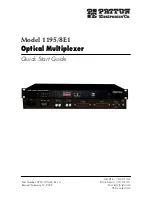
C H A P T E R 3 C O N F I G U R I N G V 1 0 0
V100 Versatile Multiplexer Technical Manual Version 2.2
Page 107 of 231
CALL TIMER
The ISDN service carries a tariff based on call duration. It is therefore advantageous to be able to limit the
maximum duration to prevent excessive call charges. The Call Timer offers a selection of times, including
a permanent mode, after which any ongoing ISDN calls are dropped.
LINE TYPE AND TEIS
The user must configure the ISDN Link Interface to operate according to the correct service type. “Point to
Point(PP)” mode requires fixed (known) Terminal Endpoint Identifiers (TEIs) to be set for Layer 2 of the
protocol to establish a connection. The number is usually 0 but may be set in the range 0-63. Layer 1 is
activated immediately with or without a call and Layer 2 comes up and stays up. This is useful for fixed
links which use the ISDN network for connectivity. It is applicable to both S0 and U0 interfaces.
“Point to Multi Point(PMP)” mode, TEIs are negotiated automatically with the network via a broadcast
channel 127 and assigned a number in the range 64-126. Layer 2 of the protocol is activated by an
exchange of SABME UA (Unnumbered Acknowledge) messages and thereafter by sequentially numbered
messages. This is stimulated by placing a call, which brings up first layer 1 and can take a few seconds to
activate. Once activated, Layers 1 and 2 will stay active until physically disconnected. It is possible
therefore that the first call may fail following line connection, but calls will always succeed thereafter. This
is true for both S0 and U0 interfaces.
ISDN PROTOCOL
When the Line Type is changed, the menu is refreshed to display the correct TEI mode. Access to the TEI
field itself is only permitted in Point-to-Point(PP) mode.
The ISDN protocols are programmed into the ISDN Link Interface Card in the factory and fall into two
choices; EURO or US. If US protocols have been provided, it is possible to select from NI(National ISDN),
AT&T 5ESS(Custom) and Nortel DMS100.
SPIDS AND LDNS
These are only applicable to ISDN connections in the USA and only therefore appear if the ISDN Link
Interface is fitted with an American software stack. The Service Profile IDentifier (SPID) is a number
assigned by the Local Exchange Carrier (LEC) or ISDN provider when the customer requests an ISDN line.
It allows the network to associate the correct level of functionality with the terminal and also to identify a
unique terminal on a BRI circuit (to which up to 8 may be connected) with the same directory number.
The generic SPID format is comprised of 14 digits which can be divided into the following three
components: a 10 digit telephone number, a 2 digit Sharing Terminal Identifier and a 2 digit Terminal
Identifier (TID). The 10 digit number is the main directory number associated with the terminal and
includes the 3 digit area code. The 2 digit TID differentiates terminals that have the same main number
and the same Sharing Terminal ID. These terminals have the same service profile, which means they
have access to the same services and translations in the ISDN network switch. TID values range from
















































